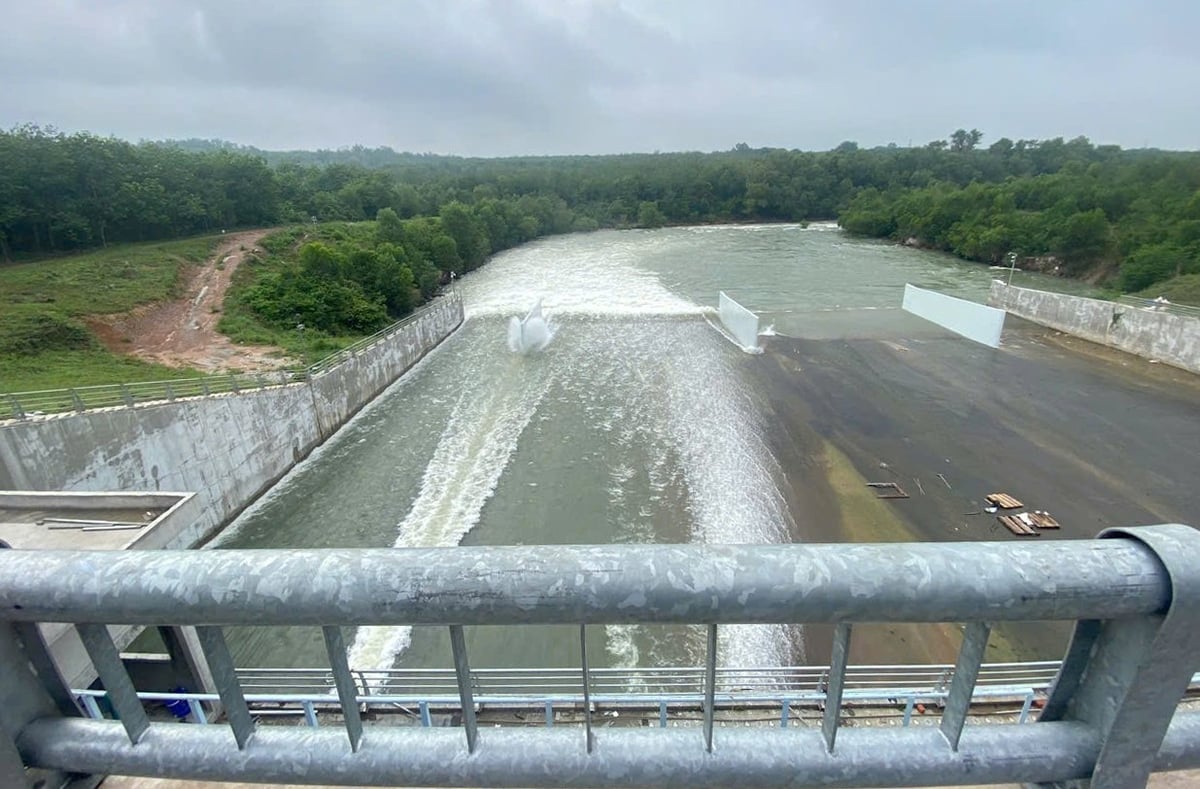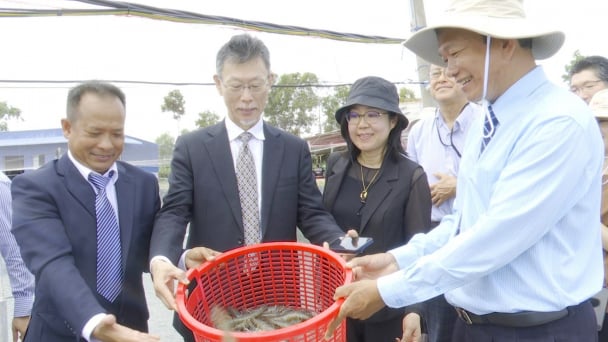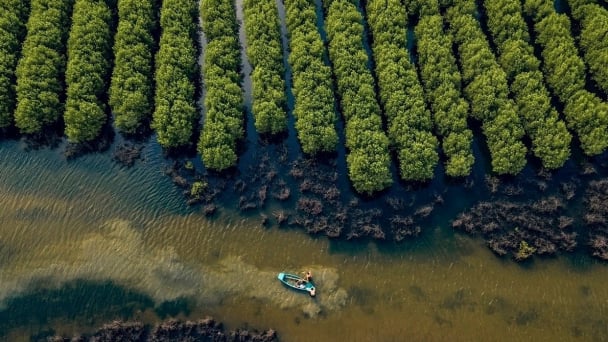June 13, 2025 | 07:14 GMT +7
June 13, 2025 | 07:14 GMT +7
Hotline: 0913.378.918
June 13, 2025 | 07:14 GMT +7
Hotline: 0913.378.918

The meteorological and hydrological forecast bulletins have helped the Southern Irrigation Management One Member Limited Liability Company safely release water from Dau Tieng reservoir. Photo: Thanh Son.
As the largest irrigation reservoir in Vietnam, with a water surface area of 27 km² and a storage capacity of 1.58 billion m³, Dau Tieng reservoir must release water through its spillway multiple times a year into the lower Saigon River for various purposes.
According to Mr. Tran Quang Hung, General Director of the Southern Irrigation Management One Member Limited Liability Company, in 2024, due to widespread heavy rainfall influenced by Typhoon No. 4 and a tropical depression, the Dau Tieng watershed experienced several significant rain events: from August 30 to September 3, September 14 - 21, October 6 - 25, and November 1 - 6. The average annual rainfall across the watershed in 2024 reached 2,021 mm, 149 mm higher than in 2023 and 215.61 mm above the multi-year average.
In 2024, at Dau Tieng reservoir, the Southern Irrigation Management One Member Limited Liability Company conducted 12 flood discharge events through the spillway, with discharge flows ranging from 36 to 200 m³/s, totaling 1,447.66 million m³. Of this, 966.34 million m³ was discharged to improve environmental conditions and reduce salinity intrusion for the Tan Hiep Water Plant; and 481.32 million m³ was released to lower the reservoir’s water level, thereby increasing flood storage capacity, protecting the dam, and mitigating downstream flood risks.
During the 12 water discharge events at Dau Tieng reservoir in 2024, many occurred at the peak of the rainy and flood season. However, all releases ensured the safety of the dam structure and the downstream areas.
To ensure safety during spillway releases from Dau Tieng reservoir, in addition to strictly following the reservoir’s operational procedures and the coordination regulations between the Ministry of Agriculture and Rural Development (now the Ministry of Agriculture and Environment) and the relevant provinces and cities, the reservoir operation conducted by the Southern Irrigation Management One Member Limited Liability Company has always been closely linked to hydrometeorological forecasting.
Based on warning and forecast bulletins from the National Center for Hydrometeorological Forecasting and regional hydrometeorological stations, the Southern Irrigation Management One Member Limited Liability Company coordinated with the Southern Institute for Water Resources Planning, the Vietnam Academy for Water Resources, and the Center for Water Resources Software Technology to develop hydrological forecast bulletins. On that basis, the company collaborated with the provinces of Tay Ninh, Binh Duong, and Ho Chi Minh City to discuss and agree on suitable operational measures for the Dau Tieng reservoir.
Mr. Pham Van Manh, Deputy Director of the Southern Institute for Water Resources Planning, stated that during the flood season, the Dau Tieng reservoir occasionally releases water downstream to create storage capacity for incoming floodwaters from upstream.
During these discharge events, if the release coincides with rising tides on the Saigon River, it could lead to flooding in Ho Chi Minh city and other downstream areas. Therefore, to ensure safety, it is essential to calculate both the discharge volume and timing carefully.
To assist the Southern Irrigation Management One Member Limited Liability Company in making informed decisions, adjusting operations to match real-time conditions, and supporting downstream localities along the Saigon River in disaster prevention and response, the Southern Institute for Water Resources Planning has issued ad-hoc forecast bulletins whenever the company prepares for water discharge from Dau Tieng reservoir.
In these special bulletins, the Southern Institute for Water Resources Planning provides detailed scenario analyses, calculating the potential impacts of releasing specific discharge volumes at particular hours and dates, such as how far the rising water may extend, the expected peak water levels at hydrological stations in the downstream area, and which low-lying zones may be at risk of flooding.
Thanks to hydrometeorological forecasts, the Southern Irrigation Management One Member Limited Liability Company has been able to determine the appropriate discharge volumes and timing during release events at Dau Tieng reservoir, thereby ensuring both dam safety and protecting downstream areas from flooding.
According to Mr. Nguyen Huy Khoi, Head of the Department of Science, Technology and International Cooperation at the Southern Institute for Water Resources Planning, in addition to the forecasting work conducted by the hydrometeorological sector, over the years, irrigation institutes have also strengthened their efforts in hydrological forecasting to support agricultural production and the operation of irrigation systems directly.

Rice production in the Mekong Delta has minimized losses during flood and drought/saline intrusion seasons thanks to the effective implementation of hydrometeorological forecasts and warnings. Photo: Thanh Son.
At the beginning of the dry or rainy season, institutes issue seasonal water source forecast bulletins. For example, in the Mekong Delta, the Southern Institute for Water Resources Planning provides seasonal water resource forecasts and develops water use plans to support water supply management for agricultural production during the flood season. Meanwhile, the Southern Institute of Water Resources Research issues seasonal forecasts to guide agricultural production and water supply operations during the dry season.
Based on the seasonal forecast bulletins from these institutes, the Department of Plant Production and Protection coordinates with localities to develop appropriate production plans. For instance, depending on the forecasted flood conditions in the Mekong Delta, authorities can determine how much area should be used for autumn-winter rice planting, which regions to focus on, and when to start sowing to ensure safety.
In addition to seasonal hydrological forecasts, the institutes also provide monthly, weekly, and ad-hoc bulletins. These bulletins directly support the operation of irrigation systems as well as disaster prevention efforts. For example, during upcoming high tide periods, the forecasts may identify which localities in the Mekong Delta are at high risk of flooding.
Mr. Khoi stated that the quality of hydrological forecast bulletins in the irrigation sector has been increasingly improved thanks to efforts in applying new technologies and enhancing the capacity of the forecasting teams.
However, aside from improving forecast quality, each type of bulletin needs to be tailored toward a specific purpose and closely integrated with irrigation systems. Equally important is the task of bringing these forecast bulletins into real-life application at the local level - down to individual communities and farmers.
During the 2015 - 2016 dry season, relevant agencies performed quite well in forecasting the severe drought and saline intrusion risks in the Mekong Delta. However, the implementation of those forecasts at the local level was still lacking. By the 2019 - 2020 dry season, although the drought and saline intrusion were even more intense, agricultural losses in the Mekong Delta were significantly lower than in 2015 - 2016. This was thanks to early and widespread dissemination of warnings from the institutes, along with responsive measures such as advancing the sowing schedule and harvesting rice earlier to avoid the peak of drought and salinity.
Mr. Nguyen Huy Khoi shared that in recent years, many localities and residents have increasingly placed their trust in hydrometeorological forecasts. Not only do they receive forecast bulletins through local channels, but some farmers have also proactively contacted staff at the Southern Institute for Water Resources Planning to request hydrological forecasts relevant to their areas.
A typical example is a young ornamental flower grower in Sa Dec, Dong Thap, who searched for Mr. Khoi’s phone number and regularly sends him messages via Zalo to request forecast information about tidal water levels in Sa Dec. Thanks to this, the farmer is always proactive in raising his bonsai pots to higher positions in the garden to avoid flooding during high tides.
Translated by Phuong Linh

(VAN) In Tien Giang, a high-tech shrimp farm has developed a distinctive energy-saving farming model that has yielded promising results.
![Turning wind and rain into action: [3] 300.000 farmers benefit from agro-climatic bulletins](https://t.ex-cdn.com/nongnghiepmoitruong.vn/608w/files/news/2025/06/12/e5a48259d6a262fc3bb3-nongnghiep-125122.jpg)
(VAN) The agro-climatic bulletin has become a valuable tool for farmers in the Mekong Delta. After more than five years of implementation, the initiative is gradually being expanded nationwide.

(VAN) Blue carbon is receiving attention for its rapid absorption capacity and vast potential. It represents a promising nature-based solution to respond to climate change.
/2025/06/11/3507-1-161904_583.jpg)
(VAN) Seagrass beds and coral reefs serve as 'cradles' that nurture life in the ocean depths, creating rich aquatic resources in Vietnamese waters.
![Turning wind and rain into action: [1] Forecasting for farmers](https://t.ex-cdn.com/nongnghiepmoitruong.vn/608w/files/news/2025/06/11/e5a48259d6a262fc3bb3-nongnghiep-111919.jpg)
(VAN) Weather is no longer just a matter of fate. Forecasts have now become an essential companion for farmers in every crop season.
/2025/06/10/2501-3-082025_983.jpg)
(VAN) Mr. Le Hoang Minh, Head of Vinamilk's Net Zero project, recently shared insights on the integration of production, energy, and technology in Vinamilk’s green transition journey.